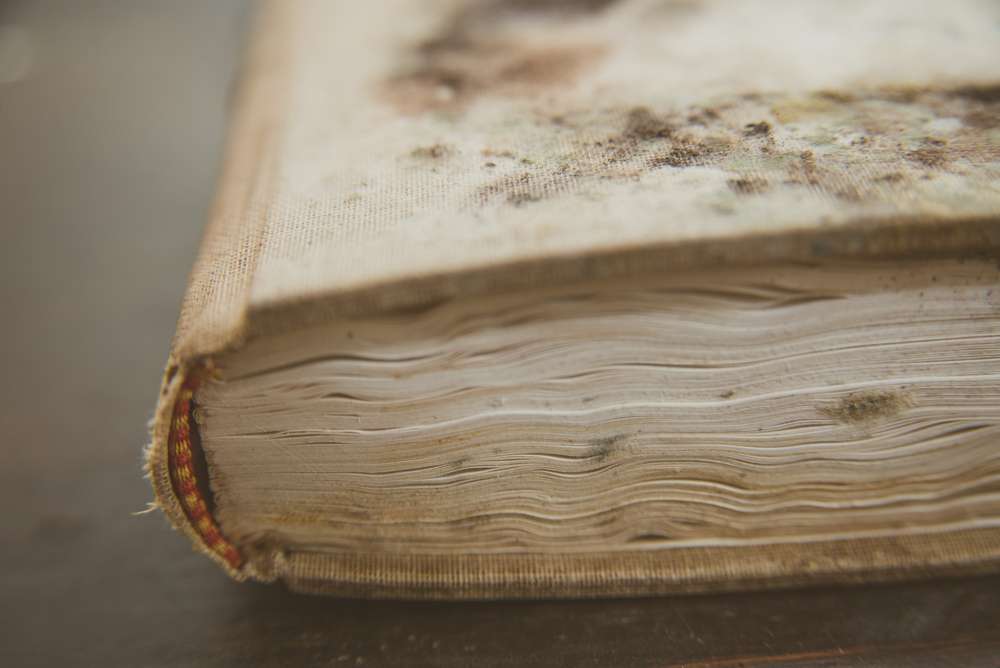
In any environment where books are kept, it is always essential to ensure that measures are put in place to preserve the books.
The fact is, if you don’t take good care of your books, you may end up losing them due to mold and other factors that can destroy them.
Having spent some time working in a library I know just how crucial book maintenance is.
The other day, one of my colleagues and I got into a conversation concerning mold and one of the questions that he asked was inquiring into whether book mold was able to spread.
This article will therefore answer this question to bring some awareness around this topic and to ensure that.. YOU, my readers take good care of your books…
With that said, does Book mold spread?
Book mold can easily spread from one book to others if the area they’re kept in has high humidity, dust build up, water leaks etc… One moldy book can ruin an entire collection when measures are not put in place to address or prevent mold.
Mold and How it Grows
Molds are basically fungi that occur naturally in the environment their role is in nature is to help break down dead materials and then convert them back into organic matter that can be used as fuel by other living organisms.
There are thousands of fungi that are known to be associated with human and animal diseases.
Everyone is exposed to mold through the air that we breath whether we are outdoors or indoors.
Mold basically grows by digesting and destroying any material that it grows on which means it is dangerous on books as it is dangerous on any thing else it grows on.
You’ll find mold in any place where oxygen and moisture is present. Mold typically reproduces by making spores which are airborne and can land on any material.
Identifying mold
You can learn to spot and identify mold.
In most cases inactive mold looks dry and powdery and can be easily brushed off.
In its early development and growth, it looks like fine webs, sometimes like blooms in clumps which merge into something termed as carpets.
Active mold is different from active mold and looks fuzzy, usually sticky damp or slimy and can be multiple different colours.
These multiple colors can grow on a single object and can sometimes be confused with dirt, dust, cobwebs or foxing.
You can also confuse staining that occurs due to water damage with staining caused by mold therefore it takes some practice.
Ways to prevent mold from spreading around your book collection
Controlled relative humidity
Mold can spread in high humidity spaces which is why it’s important to have a good general control of humidity.
You need a good balance of humidity because when it is high it will ruin your books and you’ll possibly end up with an insect infestation as well as a mold outbreak.
You also want to avoid any low humidity because this can cause your books to dry up which can be bad because it could ultimately lead to de-colouration. LEARN HOW TO PREVENT YOUR BOOKS FROM TURNING YELLOW.
Cool temperatures
Humidity is a big deal and you should certainly pay it some attention because it has the power to both preserve and destroy your books.
But other than humidity, you also want to maintain cool temperatures.
You want cool temperatures because high temperature is just as destructive as extreme low temperatures.
Set your books in a cool space and watch out for any pages curling up because this is a sign of high temperatures.
Buy you also don’t want to freeze your books with too cool temperatures.
Therefore, strike a good balance.
Air circulation
Air circulation is another important thing you have to take into account. You generally want to keep your books in space that can provide good air circulation.
The reason for this is pretty simple. Mold likes environments with high humidity and little air circulation.
Good air circulation allows you to maintain good humid levels inside the space you’re utilizing to store your books.
This is a good way to counteract mold, but you also don’t want too much air in the space because dust particles can start to accumulate.
Which can easily have your books start collecting dust which can eventually destroy them.
Monitoring
Mold is certainly something that has to he heavily considered. Which is why an effective way to maintain your books and possibly save them from mold is to constantly monitor them.
Monitor the books that you add to your collection and ensure that they don’t have mold.
If they do, your best bet is separating them from the rest of your collection.
Also monitor and check the books in your existing collection to ensure that they’re mold free.
If you keep a good monitoring schedule, you’ll ultimately maintain your books better.
Environmental Management Team
When you do find mold and aren’t sure how you can combat it and stop it from spreading, you can engage an environmental management team to help you out.
Of course professional help can be expensive but it can also be very helpful in ensuring that you don’t lose your entire collection to mold.
The advantage of hiring professionals is that they can teach you certain techniques to preserve your books as well as provide you with remedies that you can use when you notice mold.
Some remedies
Below are some remedies that you can use to get rid of mold on your books.
Deactivation
Deactivation of mold can help you bring your books back to life. you can use Desiccants which can help you do so.
You can also exposes the affected books to low temperatures thereby inducing freezing.
Freezing can be helpful in making the mold go dormant. The only Downside is that it doesn’t actually kill the mold.
If you don’t know how to freeze books then it can be helpful to have them sent to a vendor that can help.
Irradiation
With irradiation, materials are basically exposed to gamma radiation which is more effective compared to freezing because it actually kills the mold.
The only downside to using gamma radiation is that it can destroy your more fragile books so you have to be very careful.
The other downside is that using gamma radiation requires help from a professional because doing it on your own can leave you with a bunch of damaged books, so take note of this and weigh your option.
Cleaning
The remedies discussed above can certainly help but you can also use other measures to clean mold on books.
You can use a soft brush to clean, brush off the dirt and mold which can be effective in less severe cases.
You can also use a Soot Sponge to try and clean off the mold, this can be quite difficult when the mold is severe but it is still worth the try.
You can also use a HEPA Vacuum to get rid of your mold problem.
Finally you can always call in help by outsourcing a vendor or simply sending your books over to them.
Preventative measures
Below are some good preventative measures you can take to prevent mold from spreading as well as developing.
Avoid eating in work areas
Avoid eating in work areas because food particles that may drop can easily develop into mold.
So take good care to stir clear of your work area which I’d assume is the area or space you’re keeping your books in.
Keep beverages in lidded containers
Beverage exposure and spills are another thing that can lead to your area or space developing mold.
Therefore keep your beverages lidded to avoid liquid being absorbed into the area because this can have a negative impact on your books.
Keep collection material off the floor
Don’t put your books on the floor, make sure they’re well shelved.
USEFUL LINKS
Bibilio – Identify, Prevent, and Remove Mold and Mildew from Books
Inspectapedia – moldy books can be cleaned, stored, or disposed of
Seniorcareto – Is Mold In Books Dangerous
Kosoado – How To Remove Mold From Your Precious Books
JacAnswers – Can mold spread from book to book?

